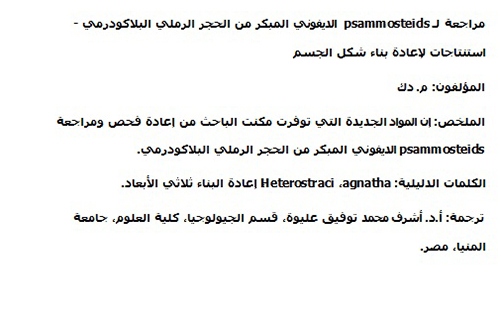Revision of the Early Devonian psammosteids from the “Placoderm Sandstone”: Implications for their body shape reconstruction
Plain Language Abstract
Psammosteids are a group of exclusively Devonian jawless vertebrates, formerly called agnathans. The fossils were collected at Podłazie Hill located about 2 km to the north of the Daleszyce, in the southern part of the Holy Cross Mountains. The material from quartzitic sandstone bone-beds (called “Placoderm sandstone”) consists of natural molds of dissolved fish remains. Tarlo (1964, 1965) described two new psammosteid species of Guerichosteus (four species included) and Hariosteus (three species included). New material obtained during field work with Piotr Szrek and Grzegorz Niedźwiedzki in 2011-2013 allows for a revision of the psammosteids formerly described by Tarlo. The analysis of ornamentation and plate morphology supports the establishment of Guerichosteus (one species G. kozlowskii) and Hariosteus (one species Hariosteus kielanae). The three-dimensional scanning of plates of Guerichosteus allows for a more detailed description and reconstruction of Guerichosteus. In cross section the deep ventral part of the trunk is V-shaped in contrast to previous U-shaped restorations. Probably, the Early Devonian psammosteids, Drepanaspis gemuendenesis in particular, shared this body shape.
Resumen en Español
Revisión de los psammosteidos del Devónico Temprano de la " Placoderm Sandstone" - implicaciones para la reconstrucción de la forma de su cuerpo
Se revisan los agnatos psammosteidos del Devónico Temprano (Guerichosteus y Hariosteus) descritos originalmente por Tarlo (1964, 1965) de la llamada “Placoderm Sandstone” ("Arenisca de placodermos"). El nuevo material recogido en las Montañas de la Santa Cruz permite una revisión detallada y proporciona nueva información anatómica. La morfología y ornamentación de las placas apoya el establecimiento de los géneros Guerichosteus y Hariosteus. Sin embargo, G. kotanskii, G. kulczyckii y G. lefeldi deben considerarse sinónimos más modernos de Guerichosteus kozlowskii. Hariosteus lobanowskii, erigido por Tarlo (1964), se considera aquí como un nomen dubium y H. kotanskii se incluye en Hariosteus kielanae. El escaneo tridimensional de las placas pertenecientes a Guerichosteus permite una descripción y reconstrucción más detallada. En la sección transversal, la parte ventral profunda del tronco tiene forma de V en contraste con las reconstrucciones anteriores en forma de U. Probablemente, el psammosteido del Devónico Temprano, concretamente Drepanaspis gemuendenesis, compartía esta forma corporal.
Palabras clave: agnato; Heterostraci; reconstrucción tridimensional
Traducción: Enrique Peñalver (Sociedad Española de Paleontología)
Résumé en Français
Révision des psammosteidés du Dévonien ancien du “Grès à Placodermes” – implications pour la reconstitution de leur forme corporelle
Les agnathes psammosteidés du Dévonien ancien (Guerichosteus et Hariosteus), décrits originellement par Tarlo (1964, 1965) d’après des fossiles du « Grès à Placodermes », sont révisés. Le nouveau matériel collecté dans les monts Sainte-Croix permet un réexamen détaillé et fournit de nouvelles informations anatomiques. La morphologie et l’ornementation des plaques soutiennent la définition des genres Guerichosteus and Hariosteus. Cependant, les espèces G. kotanskii, G. kulczyckii, et G. lefeldi devraient être considérées comme des synonymes juniors de Guerichosteus kozlowskii. L’espèce Hariosteus lobanowskii, érigée par Tarlo (1964), est considérée ici comme invalide (nomen dubium) et l’espèce H. kotanskii est incluse avec Hariosteus kielanae. Le scan tridimensionnel des plaques appartenant à Guerichosteus permet une description plus détaillée et une reconstitution. En coupe transversale, la partie ventrale profonde du tronc est en forme de V contrairement aux reconstitutions précédentes où elle était en forme de U. Il est probable que le psammosteidé Drepanaspis gemuendenesis du Dévonien ancien partageait cette forme corporelle.
Mots-clés : agnathes ; Heterostraci ; reconstitution tridimensionnelle
Translator: Antoine Souron
Deutsche Zusammenfassung
Revision der frühdevonischen Psammosteiden aus dem “Placodermen Sandstein” – Folgerungen für die Rekonstruktion der Körperform
Die frühdevonischen psammosteiden Agnathen (Guerichosteus und Hariosteus) aus dem sogenannten “Placodermen Sandstein”, ursprünglich von Tarlo (1964, 1965) beschrieben, werden überarbeitet. Das neu gesammelte Material aus dem Heilig-Kreuz Gebirge ermöglicht eine detaillierte Neuuntersuchung und liefert neue anatomische Informationen. Morphologie und Ornamentierung der Platten unterstützen die Schaffung der Gattungen Guerichosteus und Hariosteus. Allerdings sollten G. kotanskii, G. kulczyckii und G. lefeldi als Juniorsynonyme von Guerichosteus kozlowskii betrachtet werden. Hariosteus lobanowskii, aufgestellt von Tarlo (1964), wird hier als ungültig (nomen dubium) angesehen und H. kotanskii wird in Hariosteus kielanae mit einbezogen. Das dreidimensionale Scannen der Platten von Guerichosteus ermöglicht eine detailreichere Beschreibung und Rekonstruktion. Im Querschnitt ist der tiefe ventrale Teil des Rumpfes v-förmig im Gegensatz zu früheren u-förmigen Rekonstruktionen. Möglicherweise teilte insbesondere der frühdevonische Psammosteide/diese Körperform.
Schlüsselwörter: Agnatha; Heterostraci; dreidimensionale Rekonstruktion
Translator: Eva Gebauer
Arabic

Translator: Ashraf M.T. Elewa
Polski
Rewizja wczesnych dewońskich psammosteidów z „piaskowca Placodermowego” - implikacje dla rekonstrukcji kształtu ciała
Wczesne dewońskie bezżuchwowce psammosteide (Guerichosteus i Hariosteus) pierwotnie opisane przez Tarlo (1964, 1965) z tzw. „piaskowca Placodermowego”. Nowo zebrany materiał z Gór Świętokrzyskich umożliwia szczegółową analizę i dostarcza nowych informacji anatomicznych. Morfologia i ornamentacja płytek przemawiają za utworzeniem rodzajów Guerichosteus i Hariosteus. Jednak G. kotanskii, G. kulczyckii i G. lefeldi należy uznać za młodsze synonimy Guerichosteus kozlowskii. Hariosteus lobanowskii, ustanowiony przez Tarlo (1964), jest uważany za nieważny (nomen dubium), a H. kotanskii został włączony do Hariosteus kielanae. Trójwymiarowe skanowanie płyt należących do Guerichosteus pozwala na bardziej szczegółowy opis i rekonstrukcję. W przekroju głęboka brzuszna część tułowia ma kształt litery V w przeciwieństwie do poprzednich rekonstrukcji w kształcie litery U. Prawdopodobnie wczesny dewoński psammosteid Drepanaspis gemuendenesis, powielał ten kształt ciała.
Słowa kluczowe: bezżuchwowce; Heterostraci; rekonstrukcja trójwymiarowa
Translator: Krzysztof Stefaniak

